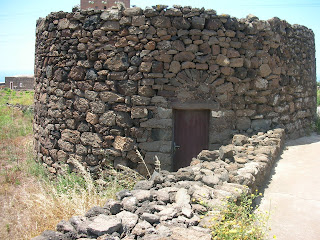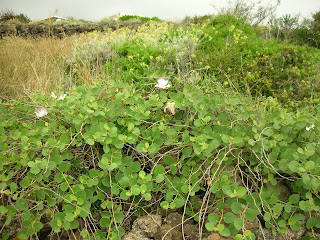 If I were a cistus I would live in Pantelleria, the small volcanic island closer to the coast of Africa than to Sicily. I could flower freely along cobbled paths that lead to solitary beaches no larger than a fingernail or impassable cliffs that natural elements have shaped in a curious way. Small shrubs with grey leaves and explosive blooms would be good company; their volatile perfumes mixed with the smell of salty air roused by a wind that never stops to blow.
If I were a cistus I would live in Pantelleria, the small volcanic island closer to the coast of Africa than to Sicily. I could flower freely along cobbled paths that lead to solitary beaches no larger than a fingernail or impassable cliffs that natural elements have shaped in a curious way. Small shrubs with grey leaves and explosive blooms would be good company; their volatile perfumes mixed with the smell of salty air roused by a wind that never stops to blow.  Despite its small size, intense human activities and dangerous fires, the surviving natural landscape is rich and varied. Woods of maritime pines cover the slopes of the “Montagna Grande” (Great Mountain). Descending from its 836 meters to sea level, they mix with oaks, arbutus and junipers. In the under bush, shrubs of the Mediterranean area predominate: brooms, heathers, mastics and myrtles together with grass and wild flowers. The “garriga” fades towards the cliffs with a simpler vegetation of drought resistant plants. Their names evoke a perfumed summer: helchrysum, thyme, rosemary, lavender and chamomile. There are some endemic species confused among them, minuscule and discreet varieties of limonium parviflorum, matthiola incana and trifolium nigrescens. In the past, all plants were used to support local life. People produced oil from the fruits of arbutus, or a kind of ink and a tincture to dye leather from myrtle, while rosemary was an ingredient for recipes and talismans against bad luck. Today, ordered cultivations of wine and olive define the landscape. Introduced several centuries ago, the vine called Zibibbo is the most cultivated one. It offers excellent table grapes, abundant raisins and a sweet, dessert wine, the Passito. Olive trees are severely pruned to protect them from the impetuous wind.
Despite its small size, intense human activities and dangerous fires, the surviving natural landscape is rich and varied. Woods of maritime pines cover the slopes of the “Montagna Grande” (Great Mountain). Descending from its 836 meters to sea level, they mix with oaks, arbutus and junipers. In the under bush, shrubs of the Mediterranean area predominate: brooms, heathers, mastics and myrtles together with grass and wild flowers. The “garriga” fades towards the cliffs with a simpler vegetation of drought resistant plants. Their names evoke a perfumed summer: helchrysum, thyme, rosemary, lavender and chamomile. There are some endemic species confused among them, minuscule and discreet varieties of limonium parviflorum, matthiola incana and trifolium nigrescens. In the past, all plants were used to support local life. People produced oil from the fruits of arbutus, or a kind of ink and a tincture to dye leather from myrtle, while rosemary was an ingredient for recipes and talismans against bad luck. Today, ordered cultivations of wine and olive define the landscape. Introduced several centuries ago, the vine called Zibibbo is the most cultivated one. It offers excellent table grapes, abundant raisins and a sweet, dessert wine, the Passito. Olive trees are severely pruned to protect them from the impetuous wind. The "giardini panteschi" (panteschi gardens) were a different solution to this problem. These circular buildings without roof were built with dry lava stones; their height varied from one to three meters. A small door, the only opening, introduced inside where proudly stood a lonely and luxuriant beauty, usually a citrus or a fruit tree. Walls protected the plant from relentless marine winds and above all retained the precious night dew or the rare rain. Their origins are lost in time, and today, after years of neglect, their future is more certain as new attention is dedicated to these examples of self-sustainable gardens.
The "giardini panteschi" (panteschi gardens) were a different solution to this problem. These circular buildings without roof were built with dry lava stones; their height varied from one to three meters. A small door, the only opening, introduced inside where proudly stood a lonely and luxuriant beauty, usually a citrus or a fruit tree. Walls protected the plant from relentless marine winds and above all retained the precious night dew or the rare rain. Their origins are lost in time, and today, after years of neglect, their future is more certain as new attention is dedicated to these examples of self-sustainable gardens.Terraced dry stone walls design regular lines. Indian figs and capers escaped from cultivated fields grow wild against them. Sometimes, these low walls enclose local vegetation that enriched with jasmine, plumbago, pomegranes, geranium and roses create small gardens for local houses, called "dammusi". Of Arabian origin, these low, square buildings are perfectly integrated in the rough landscape. Precious rain is channelled and collected in cisterns thanks to their domed roofs and their thick walls - up to 2 meteres - provide fresh and dry rooms. Built following particular construction techniques with lava rock cut by hand, they answered the practical needs of people dedicated to agriculture and breeding. Today, most of them are luxurious bed&breakfast combining tradition to modern tourist requirements.
 A couple of years ago, I spent a week there towards the end of May when the island was preparing for its crazy summer season. The day after my arrival, I joined a boat tour to see the island from a different perspective: secret coves, hidden creeks, breathless rocks and a late spring landscape shaded with combinations of pink and yellow. We ate excellent pasta with tomato sauce anchored in a romantic cove after a quick swim and a glass of wine. Simple food where different herbs, oil, tomatoes garlic and capers are carefully proportioned with salty air and hot wind. In the following days, I explored the internal too. Driving my white Fiat Panda I discovered fishing villages and those phenomena that remind its volcanic origin, such as sulfuric vapours, jets of steam called "favare" or "Lo Specchio di Venere" (Venus' Looking Glass) a small lake with incredible colours and a sulfuric-rich spring. Despite the interesting alternatives, I always went back to the sea, to those black beaches that are just bare and hot rocks that precipitate into the sea, crowded of young people and jellyfish during the long summer season.
A couple of years ago, I spent a week there towards the end of May when the island was preparing for its crazy summer season. The day after my arrival, I joined a boat tour to see the island from a different perspective: secret coves, hidden creeks, breathless rocks and a late spring landscape shaded with combinations of pink and yellow. We ate excellent pasta with tomato sauce anchored in a romantic cove after a quick swim and a glass of wine. Simple food where different herbs, oil, tomatoes garlic and capers are carefully proportioned with salty air and hot wind. In the following days, I explored the internal too. Driving my white Fiat Panda I discovered fishing villages and those phenomena that remind its volcanic origin, such as sulfuric vapours, jets of steam called "favare" or "Lo Specchio di Venere" (Venus' Looking Glass) a small lake with incredible colours and a sulfuric-rich spring. Despite the interesting alternatives, I always went back to the sea, to those black beaches that are just bare and hot rocks that precipitate into the sea, crowded of young people and jellyfish during the long summer season. Summer evenings, when the light never disappears in the sky, when the furious, sensuous and impolite wind calms down in a breeze on tanned skin, when music and kisses deafen the noise of the sea and the smell of grilled fish and pizza invades every street.
If I were a cistus, with fragile and incandescent petals that last just one day I would live in Pantelleria. Caressed by a rude wind I would never be alone, and looking down towards the sea, I would feel safe and free.
Link:
http://www.pantelleria.com/english/index.asp
Giardino Pantesco from FAI (Fondo Ambiente Italiano) to be visited by appointment:
http://www.fondoambiente.it/beni/giardino-pantesco-donnafugata-beni-del-fai.asp